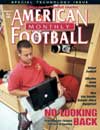AMERICAN FOOTBALL MONTHLY THE #1 RESOURCE FOR FOOTBALL COACHES
Article CategoriesAFM Magazine
|
The Money ChaseSure technology is great, but how can small schools afford it?by: Jane Musgrave © More from this issue When Michael Christensen needed money to buy high-tech equipment to revolutionize his football program at Lakewood High School in California, he got it that old-fashioned way: He went to his booster club with his palms outstretched. "Luckily, we have a real active booster club," he says of the group's ability to raise the money he needed to buy a $13,000 video-editing system. Without a good booster club or a well-heeled sugar daddy, however, most high school and small college coaches are hard-pressed to come up with the cash they need to buy new uniforms, much less sophisticated computer equipment. Like many school districts, the one in Lakewood will give coaches computers, just as they provide computers to chemistry, history and English teachers. "But you have to go through so much paperwork and it's a real time-consuming proc....The full article can only be seen by subscribers.
|
|
|||||||
| HOME |
MAGAZINE |
SUBSCRIBE | ONLINE COLUMNISTS | COACHING VIDEOS |
Copyright 2025, AmericanFootballMonthly.com
All Rights Reserved





